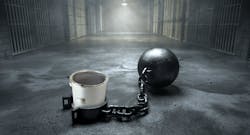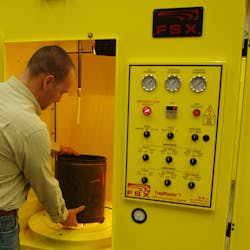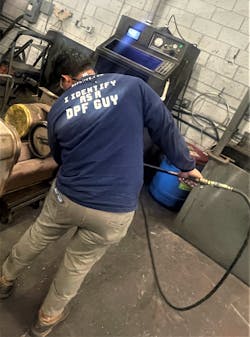Wrongfully condemned: How to give DPFs a clean record
When a truck goes down due to an emissions system problem, the diesel technician becomes judge, jury, and sometimes executioner. Oftentimes, it’s the soot-covered diesel particulate filter that gets put in front of the firing squad, though troubleshooters may be jumping the gun by so quickly condemning a dirty DPF.
Sure, they are often the guilty party. Visible cracks and soot at the outlet are good indications that a DPF is done for. But for the sake of keeping maintenance costs down, these critical emissions system components deserve due process. When following the right procedures, even the nastiest of DPFs stand a decent chance of rehabilitation.
Read more: Regenerating your DPF cleaning strategy
Here are some tips on how to ensure your DPFs aren’t wrongfully convicted, as well as the different pathways to give them a clean record.
Discovery process
Before the truck with the suspicious DPF came into the shop, the driver likely had some regeneration issues. The system should perform active regeneration, where the engine heat burns off soot from the filter on the road, but after a while, you may need to park and perform a forced regen (usually 45 minutes). According to RoadWarrior, a provider of aftermarket DPFs, if a forced regen takes an hour or longer, the soot isn’t getting hot enough to burn off, indicating intervention is required. If not addressed, the pressure built up in the clogged filter can crack the DPF.
When the truck arrives in the shop, the first thing to look up is the mileage or hours operated, depending on the duty cycle. DPFs should last more than 300,000 miles, though OEM guidelines should be consulted. If a DPF has 700,000 miles on it, for example, you may just want to replace it. Fleets should first consider cleaning the DPF.
Not all dirty DPFs are fit to be cleaned. Here’s what would earn a one-way ticket to the scrap bin:
Horizontal or vertical cracks on the cell wall
Jeremy Anderson, vice president of sales at FSX Equipment says this “depends on if the cracks are causing soot to bypass.”
Steve Hoke, president of Diesel Emissions Service (DES), advised to do a wire, or pin, test to be certain. Conducting a pin test will ensure the DPF isn’t full of hardened ash, he explained.
Accumulation of soot on DPF outlet face
"If it's smokin’, it's broken," related Steve Hoke, president of Diesel Emissions Service (DES)
Anderson agreed that soot accumulation “almost always signifies a failed breached DPF.”
He said two minutes in the FSX TrapBlaster DPF Cleaner would confirm a breach.
“If more than 20 cells are bypassing soot, then it is a failed DPF,” Anderson noted.
Discoloration on the outlet surface
This may indicate damage to the ceramic core, such as fusion or melding of the substrate brick. A pin-drop test will confirm the DPF’s integrity.
Anderson said FSX’s pin drop test method involves a straight tig welding wire.
“During the initial visual inspection, pin drop the outlet end of the DPF in seven cells (in an outer and inner circle) to check for melting,” Anderson said. “If the pin does not drop to the bottom in every cell, the filter is melted in that area. Pin around that area and if melt is greater than the size of a silver dollar, fail the DPF.”
Gouges
There’s still hope even the technician finds deep gouges. Anderson noted ceramic putty can patch such damage, but some may be beyond repair.
“If a gouge exceeds the depth of the ceramic plug and therefore causes the cell to pass all the way through leaking soot this is referred to as a black hole,” Anderson said. “If more than 20 cells bypass soot and there is no ceramic repair putty available, the DPF should be replaced.”
Rehabbing a dirty DPF
If the DPF gets past the visual interrogation, the next step is helping it clean up its act.
Read more: DPFs: To clean or replace? That’s the question.
“If everything looks good, we’ll weigh the DPF and flow test it before putting it through our cleaning process,” he continued. “Then we’ll weigh it and test it again.”
Taking these before/after measurements will help determine if the DPF requires any further cleaning. Concerning weight, Hoke said a long-haul truck with 100,000 miles under normal conditions will often see 400 grams of ash removed during cleaning. The more important insight, however, is airflow.
“It’s really important to understand the baseline numbers for the flow test table being used,” Hoke said. “Let’s say that prior to being cleaned, a DPF flow tested at 4.4” of water. If the baseline for that specific filter on that specific table is 2.2”, and the filter tested at 3.8” after being cleaned, the technician knows the filter hasn’t been cleaned well enough.”
Later, after the pneumatic cleaning, pin drop 21 cells on the inlet side (in a circle like each hour on a clock face both an outer and inner circle and one in the center) to check for any remaining hardened ash. If the average ash is more than ½” at the bottom of the DPF, the truck’s owner should reduce their PM schedule by 50,000 miles to stay ahead of the hardened ash. No need to fail a DPF due to the ash plug because the airflow test bench will reveal if the back pressure is out of spec.
Now let’s look at how some of the top equipment manufacturers go about cleaning a DPF, with specific shop equipment to help perform the task:
Pulse cleaning
DES brand Filtertherm’s Pulse Cleaner is an automated process that uses a high-velocity, low-pressure air pulse to blow out DPFs. Hoke said it’s a 15-minute process and is the first thing the technician does after inspecting and testing a DPF. After that initial cleaning, the filter is baked in an oven to oxidize any remaining soot. The filter is then blown out one more time.
Bidirectional air scanning
FSX Equipment’s pneumatic cleaning machine, the TrapBlaster, utilizes two nozzles to deliver bidirectional air scanning.
“With the lower nozzle at the inlet side, we overwhelm each cell with enough psi and cfm that the ash plug is broken up,” Anderson said. “Then, the upper nozzle at the outlet side is blowing that loose debris out.”
According to Anderson, the automated TrapBlaster process takes about 20 minutes. It will often remove 99% of the soot, making the baking process unnecessary. “We’ve found that 80% of DPFs can be thoroughly cleaned just by using our pneumatic cleaner,” Anderson said.
Manual air cleaning
Enviromotive's EvacuBlast is based on manual cleaning. According to Jim Sutherland, director of equipment sales, placing a cleaning tool in the hands of a technician provides an advantage—especially when dealing with a common problem with dirty DPFs.
“We refer to it as gumball,” Sutherland said. “It’s that sticky mass of soot in about 30% of the filter. If you don’t get that gumball clean, it’s really no better than a once-over.”
The technician uses a handheld cleaning gun while a video camera captures what is going on. Soot can be seen shooting out of the DPF cells. When the technician happens upon a stubborn gumball, soot won’t be seen shooting out. “The technician knows to spend a little more time in that area,” Sutherland said.
The thought of a manual cleaning process may sound more time-consuming and costly. But the typical cleaning only takes around 12 to 15 minutes, according to Sutherland. Furthermore, Sutherland said it’s a task that doesn’t require great skill or training.
Aqueous
Sometimes a fleet may determine that a wet cleaning will produce the best result. Downtime is an important consideration when making that decision.
“You can do a forced regen to essentially bake the filter while on the truck,” Hoke explained. “Then you pull the DPF, weigh it and flow test it, soak it with a cleaning agent, wash it, dry it, and put it back on the truck in under two hours. That quick turnaround is why we’ve started selling so many aqueous systems.”
Sometimes wet cleaning is needed to follow up a pneumatic cleaning. FSX, for example, talks about its three-stage cleaning system. Air cleaning gets 80% of filters back in service, thermal cleaning (baking) gets another 15%, and wet cleaning gets the rest.
James Wendt, managing partner at DPF Guys in Atlanta, uses Enviromotive’s EvacuBlast (air) and EvacuFlush (aqueous) cleaning equipment—often in combination. Wendt first started doing this upon a prominent fleet customer’s request. Now it has become standard procedure.
“Air cleaning typically gets a DPF about 75% cleaned out,” Wendt said. “Wet cleaning gets the remaining 25%. Our goal is always to get a DPF as close to new as possible before it goes back on the truck. This process allows us to do that.”
Is aqueous a better cleaning method than pneumatic? Not necessarily, according to Hoke. Each method will get the job done if performed correctly. That includes using effective equipment, following the proper cleaning and testing procedures, and committing to a good preventive maintenance schedule that ensures a DPF isn’t harder to clean than it needs to be.
About the Author

John Hitch
Editor-in-chief, Fleet Maintenance
John Hitch is the award-winning editor-in-chief of Fleet Maintenance, where his mission is to provide maintenance leaders and technicians with the the latest information on tools, strategies, and best practices to keep their fleets' commercial vehicles moving.
He is based out of Cleveland, Ohio, and has worked in the B2B journalism space for more than a decade. Hitch was previously senior editor for FleetOwner and before that was technology editor for IndustryWeek and and managing editor of New Equipment Digest.
Hitch graduated from Kent State University and was editor of the student magazine The Burr in 2009.
The former sonar technician served honorably aboard the fast-attack submarine USS Oklahoma City (SSN-723), where he participated in counter-drug ops, an under-ice expedition, and other missions he's not allowed to talk about for several more decades.

Gregg Wartgow
Gregg Wartgow is a freelancer who Fleet Maintenance has relied upon for many years, writing about virtually any trucking topic. He lives in Brodhead, Wisconsin.



